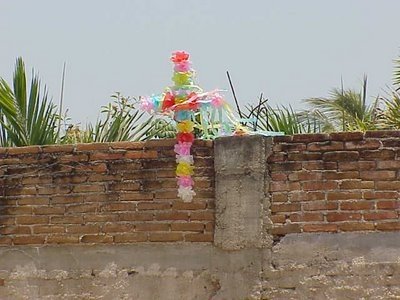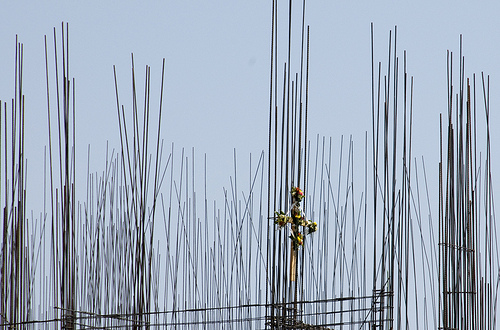 As you may recall, in Mexico there are many festivities linked with religion and others (more official and not always as colorful) that have to do with the building of Mexico as a nation. Following Labor Day (May 1st) we now come upon 3 de mayo, the Day of the Holy Cross (honoring bricklayers and builders).
As you may recall, in Mexico there are many festivities linked with religion and others (more official and not always as colorful) that have to do with the building of Mexico as a nation. Following Labor Day (May 1st) we now come upon 3 de mayo, the Day of the Holy Cross (honoring bricklayers and builders).
The history behind this day’s celebration falls to rituals practiced by Pre-Colombian cultures when calling for rain and a good harvest; as such, it was done at the beginning of the agricultural cycle around the early days of May.
Various historians affirm that when Spanish evangelists arrived to the older Mexican territory, they modified some of the pre-Hispanic beliefs so they would be similar to Catholicism.
Therefore, during the colonization period of Mexico (1521-1821), the pre-Hispanic rain ritual to Tláloc, the Aztec God of Rain, transformed into prayers for good harvest and was incorporated into devotion for the Holy Cross. It is also told this religious tradition had its beginnings in Ancient Rome under Constantine the Great.
Nevertheless, in Mexico this day is now celebrated mostly by those involved in construction: architects, riggers, contractors, and particularly bricklayers who enjoy a day off at the work site itself where they traditionally organize a large group meal.
After decorating the highest visual spot on the construction with a cross, they go to church to give thanks for their work that allows them to earn a living.
This celebration probably began in earnest toward the end of the 19th century, beginning of the 20th, as construction had an important surge both in cities as well as in rural areas and various farmers became construction workers; that is also when festivities and customs began to migrate, adapting veneration for the Cross in order to protect their new livelihoods and help them complete a project well.
An additional interesting note about May 3rd is that on December 20, 1993, the General Assembly of the United Nations, through a recommendation of the Economic and Social Board, acknowledged May 3rd as the World Press Freedom Day (decision 48/432).
3 de mayo ~ Día de la Santa Cruz
 Recuerdan que hemos hablado de que en México hay muchas festividades ligadas a la religión y otras tantas (más oficiales y no siempre tan coloridas) que tienen que ver con la construcción de México como nación. Después del día del Trabajo (1 de mayo) sigue el 3 de mayo, el Día de la Santa Cruz.
Recuerdan que hemos hablado de que en México hay muchas festividades ligadas a la religión y otras tantas (más oficiales y no siempre tan coloridas) que tienen que ver con la construcción de México como nación. Después del día del Trabajo (1 de mayo) sigue el 3 de mayo, el Día de la Santa Cruz.
La celebración de este día tiene su antecedente en los rituales practicados por las culturas precolombinas para la petición de lluvias y la obtención de buenas cosechas, que se efectuaban al inicio del ciclo agrícola, alrededor de los primeros días de mayo.
Varios historiadores afirman que cuando los evangelizadores españoles llegaron al antiguo territorio mexicano, modificaron algunas de las creencias prehispánicas a efecto de que tuvieran similitudes con las de la religión católica.
Es así que durante la Colonia (1521-1821), el ritual prehispánico para la petición de lluvia a Tláloc, dios de la lluvia, se transformó en rezos para las buenas cosechas y se incorporó a la devoción de la Santísima Cruz. Claro que también esta tradición religiosa tiene sus indicios en la Antigua Roma con Constantino el Grande (según se cuenta).
Sin embargo este día es celebrado mayormente por gremios involucrados en la construcción arquitectos, aparejadores, contratistas, pero muy especialmente por los albañiles que disfrutan de una jornada de descanso que ocurre en la propia obra, dónde se organiza una buena comida en grupo.
Tras decorar la obra con una cruz en lo más alto de esta vistosamente ataviada, acuden a una iglesia para dar gracias por el trabajo que les ocupa y que les permite ganarse la vida.
Probablemente se empezó a celebrar con más ahínco a finales del siglo XIX inicios del siglo XX, gracias a que la construcción tuvo un auge importante tanto en ciudades como en zonas rurales y varios agricultores se convirtieron en trabajadores de las construcciones, entonces así emigraron también sus fiestas y costumbres, adaptando la veneración a la Cruz para que protegiera sus nuevas profesiones y llevara a buen fin la obra.
Un dato curioso sobre este día también es que este 3 de mayo: El 20 de diciembre de 1993, la Asamblea General de las Naciones Unidas, por recomendación del Consejo Económico y Social, reconoció el día al declarar el 3 de mayo Día Mundial de la Libertad de Prensa (decisión 48/432).
